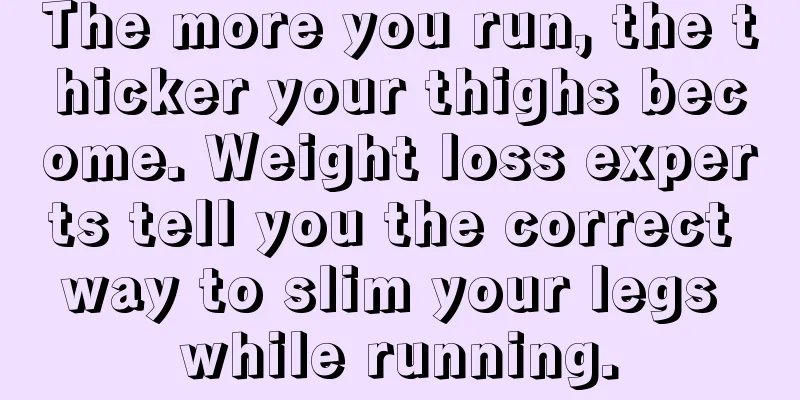The more you run, the thicker your thighs become. Weight loss experts tell you the correct way to slim your legs while running.

|
A very popular saying is that running will make your legs thicker. Similar articles are widely circulated on the Internet and in WeChat Moments. For girls who love beauty, running has become a psychological barrier. In fact, as long as you adjust your running posture and pay attention to your running method, this situation will not occur. Let me first talk about an illusion. Some people feel tired and tight in their calves when running, and think that their calves are "growing thicker". In fact, this is mostly an illusion. Growing muscles is not as easy as you think, especially for women. The body secretes very little hormone needed to synthesize muscles, making it difficult to form muscles. In most cases, it is due to swelling of the calf muscles after exercise, which can be relieved by stretching and massage. The real culprit of thick thighs is fat When your legs are not exerting force, anything you can pinch with your hands is fat. It is much easier to lose fat than to gain muscle. After a period of aerobic exercise, most people will lose fat and tighten their muscles. In other words, running not only does not make your legs thicker, but also has the effect of slimming your legs. A look at long-distance and short-distance runners seems to offer some clues. Long-distance runners tend to be lean, with long, slender-looking leg muscles and calves that are not thick but rather have beautiful lines. Sprinters have larger leg muscles, especially strong calf muscles. This is because sprinters land on their toes when running, which helps them speed up. This running method uses the calf muscles more, so the calves are generally thicker. The growth of muscles depends entirely on the stimulation you give them. Long-distance running has limited stimulation on the calves and will not make them thicker. Let’s talk about the method: We can make specific adjustments in running posture, running speed, warm-up before running and stretching after running. Adjust your running posture: The position where the sole of your foot touches the ground is very important. Try not to land on the forefoot. This will require a lot of strength in your calves. Your calf muscles may become increasingly thicker under long-term stimulation. Also, don't land completely on your heels, as this will put a lot of pressure on your knees. When landing, use the area in front of your heel to touch the ground, and then quickly transition to the entire sole of your foot. This will protect your knees and save energy. Slow down: Running is an aerobic exercise. It consumes excess body fat through exercise and achieves the goal of losing weight. Therefore, this kind of exercise needs to be performed in an aerobic state, and jogging fits this condition. Of course, the specific speed varies from person to person. The easiest way is to find a partner to run with. If you can talk and laugh while running, and can finish a whole sentence without being interrupted by breathing, then this speed is right. Heart rate control when running: Within the heart rate range of aerobic exercise: (220-age) × (60%-80%). For example, for a 20-year-old person, his aerobic exercise heart rate range is 120 to 160 beats/minute. When you exercise within the aerobic heart rate range, your body will consume fat for energy. If the speed is too fast, the stimulation to the calf muscles will be greater, thereby accelerating muscle growth and causing the calves to become thicker. Warming up before running and stretching after running are essential: many sports injuries occur in the early stages of training, and warm-up exercises are helpful in preventing injuries and speeding up the body's recovery. Stretching and relaxation exercises after exercise can speed up the relief of fatigue and the removal of metabolic products. After running, remember to do some stretching and rubbing to relax your calves. Stretching can fully stretch muscles and tendons, relieve symptoms of tension, and is also helpful in improving body flexibility. Keep the motionless muscles stretched for a certain period of time, so that the calves will not become thicker, but the lines will become better and better. |
>>: Exercise to lose weight during menstruation. Do these 6 exercises to detox and lose weight
Recommend
The benefits and effects of exercise on the heart
Exercise has many benefits for the heart. Fat chi...
How about waist and abdominal strength training for basketball?
Nowadays, many people do strength training, and t...
How to train calf muscles
When doing fitness, we usually focus on training ...
What is the best time to exercise?
As the cold winter is approaching, many middle-ag...
What exercises can help you grow taller?
People with tall stature generally will not be bu...
What is the fastest ball sport?
There are many ball sports, and we often play som...
What are the benefits of running?
Running is a sport that is very familiar to each ...
Can regular running help you build muscle?
Many people often want to have a perfect figure a...
Several sports methods for young people
Nowadays, many young people do very little exerci...
Some of the most effective abdominal muscle exercises
In today's life, many of my friends who are r...
Can patients with cervical spondylosis practice yoga?
There are many taboos in doing yoga. Yoga is a ki...
What are some ways to lose weight by running at night?
When many people want to lose weight, the first t...
Gym Fitness Program
With the faster and faster development of moderni...
What equipment do you need for hiking?
Mountaineering is a particularly beneficial sport...
Can skipping rope help you lose weight? Where can you lose weight?
Rope skipping is a very good aerobic exercise tha...









